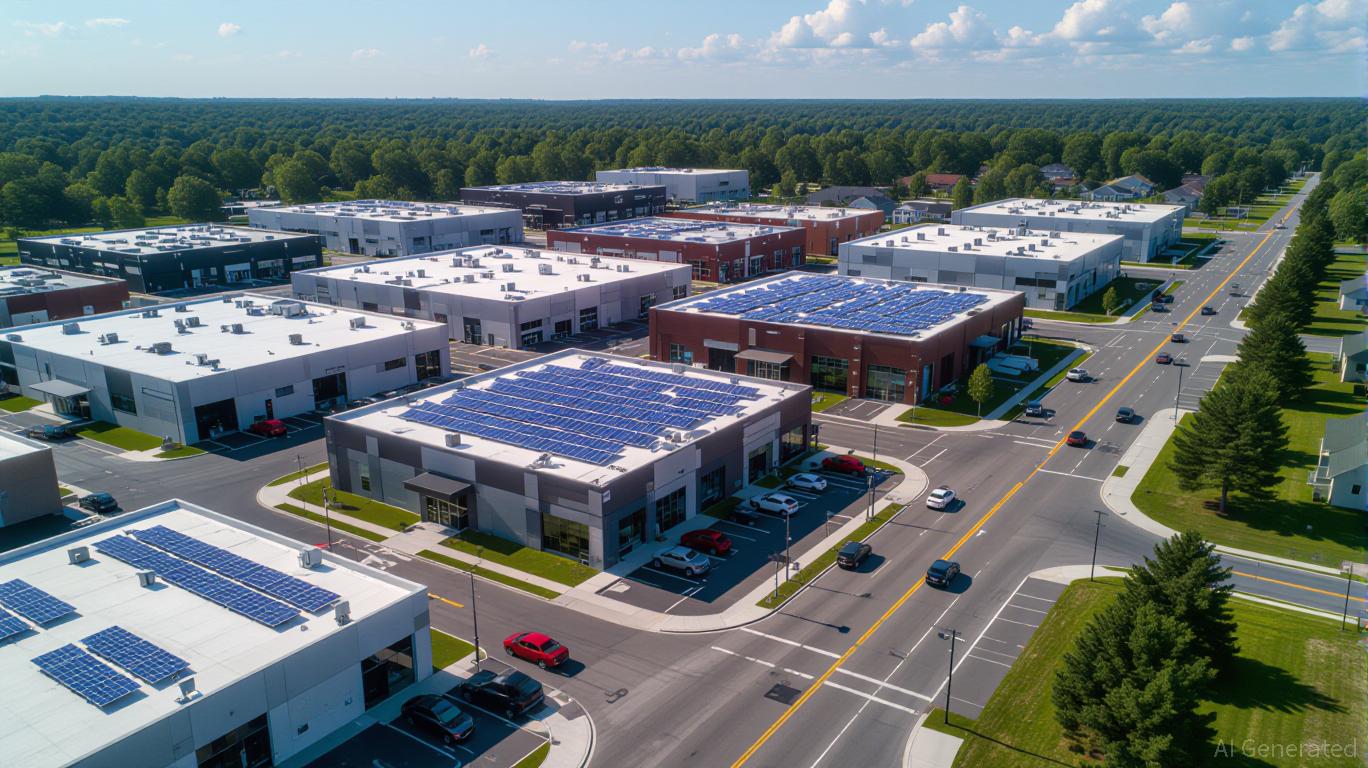Municipal Infrastructure Driving Economic Expansion and Real Estate Development: A Case Analysis of Webster, NY
- Webster , NY's $9.8M FAST NY grant transformed a 300-acre brownfield into a competitive industrial hub with upgraded infrastructure, attracting $650M private investments like the fairlife® dairy plant. - Strategic infrastructure spending reduced industrial vacancy rates to 2% (vs. 7.3% national average) and drove 10.1% residential property value growth, creating a self-reinforcing economic cycle. - Public-private partnerships, including brownfield remediation and mixed-use redevelopment, diversified Webs
Webster, NY: A Blueprint for Economic Renewal Through Infrastructure Investment
The revitalization of Webster, New York, stands as a powerful example of how thoughtful public investment in infrastructure can spark growth in commercial real estate, drive industrial expansion, and rejuvenate local economies. By exploring the impact of a $9.8 million FAST NY grant and the transformation of the former Xerox campus, we see a roadmap for investors interested in regions where public-private collaboration paves the way for sustainable, long-term gains.
The Power of Infrastructure in Economic Growth
Infrastructure improvements go far beyond basic repairs—they lay the groundwork for business success. In Webster, the FAST NY grant enabled vital upgrades to a 300-acre brownfield, including modernized electrical grids, increased sewer capacity, and redesigned roadways. These enhancements have positioned Webster to compete with established industrial centers in the Sun Belt and Midwest, making it an attractive destination for logistics and manufacturing companies.
Governor Kathy Hochul’s initiative to develop “shovel-ready” sites is clearly visible in Webster’s progress. The area has already drawn major private investments, such as the $650 million fairlife® dairy facility, expected to generate 250 new jobs. This demonstrates how infrastructure funding can attract advanced manufacturing and renewable energy businesses. By 2025, the site is projected to offer over one million square feet of industrial space, highlighting the scalability of such development strategies.
Commercial Real Estate: Vacancy and Value on the Rise

The benefits of infrastructure-led development are clearly reflected in Webster’s commercial property market. By 2025, industrial properties in the town are expected to have a vacancy rate of just 2%, a sharp contrast to the national average of 7.3%. This low vacancy rate signals strong demand from logistics and manufacturing firms, attracted by Webster’s access to Buffalo’s port and rail networks, competitive energy costs, and a skilled labor force.
Residential real estate is also thriving, with home values rising by 10.1% over the past year. This surge is directly linked to the town’s strategic infrastructure investments, which not only draw businesses but also improve quality of life for residents. The resulting cycle—where commercial growth fuels residential demand, and vice versa—creates a robust foundation for ongoing prosperity.
Strategic Collaboration: Public and Private Sectors in Sync
Webster’s achievements are rooted in strong cooperation between public agencies and private investors. The FAST NY grant played a crucial role in reducing risk for private developers by covering the initial costs of land remediation and infrastructure upgrades. This partnership is especially important in regions like Upstate New York, where historic underinvestment has slowed economic progress.
The demolition of the 600 Ridge Road property, part of the West Webster Hamlet Revitalization Project, is another example of this approach. By converting underused land into mixed-use developments, Webster is building a diverse economic base that is less vulnerable to industry-specific downturns. These projects foster vibrant communities where innovation, manufacturing, and residential life can flourish together.
Investor Takeaways: Recognizing Opportunity in Infrastructure
For investors, Webster’s story underscores the value of targeting areas where infrastructure spending is driving meaningful change. The town’s success in attracting a $650 million dairy plant—an investment unlikely to materialize without robust infrastructure—shows the powerful ripple effects of strategic public funding.
Moreover, the data reveals that these projects deliver benefits beyond immediate job creation. The 10.1% increase in home values and the anticipated one million square feet of new industrial space demonstrate the compounding returns of infrastructure-driven development. Investors in commercial, industrial, or residential properties in Webster are well-positioned to benefit from this virtuous cycle of growth.
Conclusion: Infrastructure as a Catalyst for Lasting Value
Webster, NY, exemplifies how cities that prioritize infrastructure as a driver of economic and real estate development can achieve remarkable results. The FAST NY grant and the redevelopment of the Xerox campus show that targeted public investment, combined with private sector initiative, can transform neglected sites into engines of prosperity. For investors, the message is clear: regions that treat infrastructure as a strategic asset offer fertile ground for enduring value creation.
Disclaimer: The content of this article solely reflects the author's opinion and does not represent the platform in any capacity. This article is not intended to serve as a reference for making investment decisions.
You may also like
ICP Value Jumps 30% Following Significant Network Update and Changes in Adoption
- ICP's 30% price surge in late 2025 follows major upgrades like Caffeine (AI-powered dev tools) and Chain Fusion (cross-chain interoperability), enhancing scalability and enterprise appeal. - Institutional partnerships with Microsoft and Google Cloud validate ICP's hybrid cloud potential, while Flux/Magnetosphere upgrades aim to match centralized cloud performance through TEEs. - Despite 1.2M active wallets and $1.14B daily transactions, dApp engagement fell 22.4%, highlighting gaps between infrastructure

Prediction Markets Face Legal Challenges as Kalshi’s Value Soars to $11 Billion
- Kalshi's $11B valuation doubles after $1B funding led by CapitalG and Sequoia, signaling institutional confidence in prediction markets. - Regulatory divergence emerges as Polymarket gains CFTC approval while Kalshi faces Nevada gaming law challenges over sports contracts. - Enlivex Therapeutics raises $212M via prediction market-linked strategy, highlighting sector maturation and cross-industry adoption. - Prediction markets increasingly reshape traditional finance, with CFTC licensing enabling broader

Bitcoin Updates: Federal Reserve's Shift to Dovish Stance—Will It Propel Crypto or Heighten Uncertainty?
- The Fed's end of quantitative tightening and potential December rate cut signal a dovish pivot, likely boosting crypto markets by improving liquidity and lowering holding costs for assets like Bitcoin . - Bitcoin's recent price rebound above $90,000 and January 2024 spot ETF approvals have institutionalized crypto exposure, though ETFs trade direct ownership for custody security. - Altcoins may gain from Bitcoin's declining dominance, while regulatory moves like Abu Dhabi's Ripple stablecoin approval hig

As cryptocurrency fraud becomes more sophisticated, Interpol strengthens its unified crackdown
- Interpol labels crypto scam networks a global threat, citing $11B in cross-border fraud since 2023. - Scam compounds use forced labor and blockchain tech to evade detection across 60+ countries. - 2024 operations achieved 2,500 arrests, but networks persist in Southeast Asia and expand globally. - Finland's caller ID tech reduced scam losses by 99.9%, highlighting tech-innovation's role in combating fraud.
